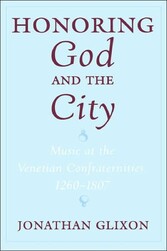
Honoring God and the City. Music at the Venetian Confraternities, 1260-1807

von: Jonathan Glixon
Oxford University Press, 2003
ISBN: 9780195134896
Sprache: Englisch
390 Seiten, Download: 2651 KB
Format: PDF, auch als Online-Lesen
6. So Super-Excellent (p. 149-150)
Music for the Annual Festa, 1500–1650
Since all of the scuole ostensibly participated as equals at civic processions, each of them presumably drew equal attention from the onlookers. The of.cers of each scuola were concerned, above all, to maintain the scuola’s honor by ensuring that, among other things, they appeared with musicians at least as numerous and as good as those at the other scuole. At the annual feast of the patron saint of each scuola (usually referred to as "nostra festa"), however, all eyes were on the host institution. The other scuole came to visit, and, because participants could almost always receive the bene.t of an indulgence, Venetians and foreigners of all sorts, sometimes even including ambassadors and the doge, came to the religious services. For St. Roch, St. John the Evangelist, and St. Theodore, the celebration at the scuola was the only substantial one in the city held that day.
For the others, the multiplicity of major events on the day itself necessitated more complicated planning. Many churches organized celebrations for the Annunciation and Conception of the Virgin (the feste of the Carita` and Misericordia), but these were usually in the morning, as was the of.cial commemoration of the feast of St. Mark in the Piazza and Basilica. In the afternoon, then, attention shifted to the respective scuole. This was the one event at which the scuole, and in particular the guardian grande and other of.cers, could best demonstrate their wealth and prestige. In order to accomplish this, the scuole often expended great sums of money.
The celebrations, as referred to in chapter 2, included several elements, which took place either in the scuola’s hall or in the associated church (or both): Vespers on the vigil of the feast,1 Mass and Vespers on the day itself, and often a procession in the vicinity of the scuola. The scuola elaborately decorated both hall and church: they displayed relics and their most elaborate liturgical apparatus, installed luxurious cloth hangings, exhibited paintings and silver objects normally kept out of public view (this became an especially important feature at San Rocco, where wealthy patrons added to the display with their own possessions),2 and completed the visual picture with .owers and greenery.
All the priests associated with the scuola participated in the sung Vespers and solemn High Mass, and, of most concern here, the scuole and their of.cers usually added signi.cantly to the regular complement of salaried musicians. All of this, of course, cost a great deal of money, especially as each new guardian (along with his of.cers) wanted to be sure not only to look good in comparison with the other scuole, but also, and perhaps equally important, in comparison with his predecessors in the same position. This striving for personal honor and glory, beyond that which would come to the scuola itself, led to cycles of rapidly increasing expenditures, and disputes between the guardians and membership over the source of the funds.
Allocations by the scuole were often not suf.cient for the desires of the guardians, who only sometimes successfully persuaded the chapter to authorize greater expenditures from the often scanty coffers of the scuola. Other times, the scuola made the decision to place all or most of the .nancial burden on the shoulders (or, rather, pockets) of the individual guardian, sometimes with the assistance of the other of.cers.







